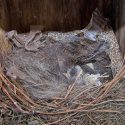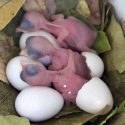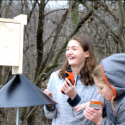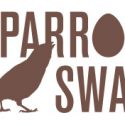 Photo ©
Keith Williams
Photo ©
Keith Williams

Wanted: Flycatcher Nest Photos
Great Crested Flycatchers and Ash-throated Flycatchers have a curious habit of adding snake skins to their nests. But, why do they do this? If you find a nest of either species this spring, take a photo and submit it to NestWatch to help us understand this unusual behavior. We’re collaborating with Dr. Vanya Rohwer of the Cornell University Museum of Vertebrates to address three main questions:
1. Does the use of snake skins in nests vary across the breeding range?
2. Where in the nests do flycatchers place snake skins (e.g., touching eggs, around the entrance hole, or scattered throughout the nest cup)?
3. Do snake skins increase nesting success?
How to take photos: Great Crested and Ash-throated Flycatchers are cavity nesters, so these directions assume that you’ve found a nest in a box. Please take photos looking straight down onto the nest so that the nest cup, eggs/nestlings, and box walls are visible. In order for photos to be used, they must be in focus and sufficiently bright so that we can see snake skins inside the nest (or lack thereof). Whenever possible, avoid using your flash; if flash is necessary, take only one photo and make sure that there are no nest predators nearby. Please submit photos through the mobile app or directly in the nesting data entry form online (please do not submit to the Participant Photos public gallery or via email). In this way, your photos will be directly linked to the nest location, nesting data information, and your user ID.
If you live in an area with an open forest habitat (urban or suburban neighborhoods with mature trees, old orchards, lake or riverside areas with large shade trees) within the range of these species, you can put up a nest box to attract either Great Crested Flycatchers in the east or Ash-throated Flycatchers in the west. For the best chance of success, avoid placing the nest box in open agricultural areas or dense forest.

New Purple Martin Nest Box Plan
We are pleased to report that we have updated our Purple Martin nest box plan in the All About Birdhouses section of our website. The new plan, which accommodates six martin nests, features larger nest compartments and the option of crescent-shaped entrance holes (we recommend the crescent-shaped holes because they deter European Starlings). The plan also includes instructions for mounting on a pole with a pulley system for raising and lowering the house.
Many thanks to Mel Lehman, designer of the “Cedar Suite” martin house, for sharing his detailed plans with NestWatch. We’d also like to thank Joe Siegrist, of the Purple Martin Conservation Association, for assistance during the process.
To find out if you’ve got the right habitat and location to attract Purple Martins, and to download the free nest box plan, visit us online. Purple Martins are in decline in parts of their range, and are almost entirely dependent on human-provided housing. Please report any martin nests to NestWatch.org.

Youth Workshops a Hit
Pine nest boxes lay across the picnic table, waiting to be installed on metal conduit with predator guards. Youth gather and work together determining the best location to install the nest boxes for our target species: Eastern Bluebirds, Tree Swallows, House Wrens, and Black-capped Chickadees. We wonder aloud, “Might we attract Tufted Titmice this year?” Soon installation is underway, and laughter fills the air along with the high-pitched whir of battery-powered screwdrivers.
This nesting season marks the second year of our NestWatch workshop series. With the help of 4-H partners in two New York communities, NestWatch is in the process of piloting a curriculum aimed at engaging youth with STEM (Science, Technology, Engineering, and Math) using nesting birds as a “hook.” Throughout the three-part workshop series, youth install nest boxes, learn about breeding bird biology, monitor nest boxes, collect and analyze data, and build their own nest boxes. In the next several years, the curriculum will be hosted on the NestWatch website, freely available for educators, community members, and families. We look forward to sharing this fun resource with you!
In addition to the Cornell Lab of Ornithology, partners include Sustainable Forestry Initiative (SFI), Cornell University Cooperative Extensions of Columbia-Greene and Jefferson Counties, and New York State 4-H with additional support from the USDA National Institute of Food and Agriculture for Smith-Lever project 2015-16-110.

Sparrow Swap Returns For 2nd Season
House Sparrows are a non-native species that compete for cavities with native birds throughout North America. While this ubiquity can make them a nuisance around nest boxes, it can also make them a really good study subject for learning about widespread problems like environmental toxins.
The Sparrow Swap Project invites you to collaborate in citizen-science research with a three-fold mission: (1) determine if House Sparrow eggs can be used to map exposure to environmental contaminants, (2) test the effectiveness of different House Sparrow management techniques, and (3) investigate the geographic variation in the color and speckling of House Sparrow eggs.
All you need to participate is a nest box that is currently attracting House Sparrows. Visit Sparrow Swap to get more information and sign up. Sparrow Swap is a project of the North Carolina Museum of Natural Sciences. If you have questions about the project, please refer to the Sparrow Swap FAQs. NestWatch reminds you that only the eggs of non-native species may be collected without a permit. If you’re unsure about the species, do not remove any eggs.